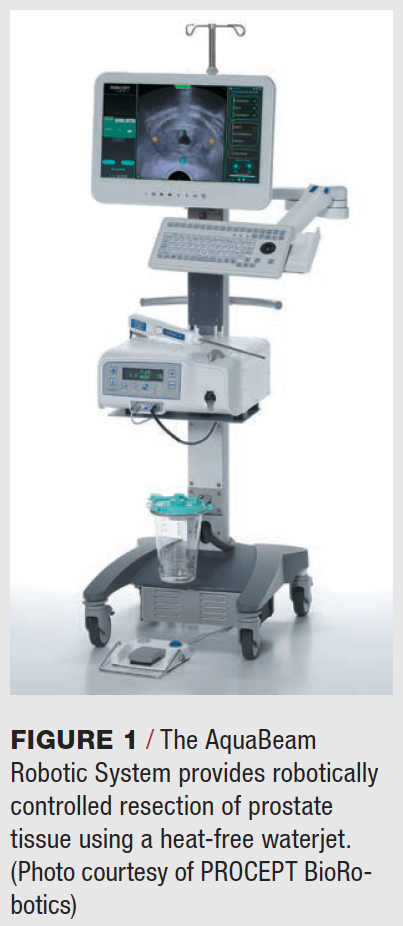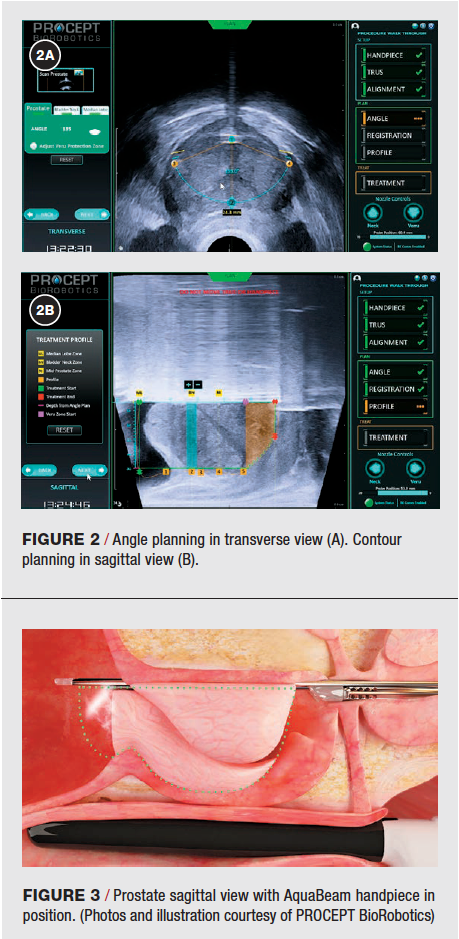Publication
Article
Urology Times Journal
Waterjet ablation offers minimally invasive option for BPH
Author(s):
The treatment provides an alternative to simple prostatectomy in men with large prostates.
Over the past several years, urologists and men suffering from BPH have been introduced to a growing number of alternatives for managing this disease. In addition to the gold-standard transurethral resection of the prostate (TURP) and the simple prostatectomy (for larger prostates), urologists can now present men with symptomatic bladder outlet obstruction a variety of newer management options including UroLift and Rezum for prostate volumes 30-80 grams. In clinical practice, some urologists are also performing these procedures in men with prostates >80 grams.
Other treatment options include photoselective vaporization of the prostate, holmium laser enucleation of the prostate (HoLEP), and variations of the more conventional treatments, such as the bipolar/button TURP and robot-assisted laparoscopic simple prostatectomy.
Each of these treatments has shared and individual risks and benefits that must be weighed and, of course, compared to the more conservative alternatives when considering “what to do next” in the personalized care of men with BPH requiring or desiring intervention. This article focuses on Aquablation, a newer approach to treatment involving the use of robotically controlled waterjet ablation for prostate tissue removal.
Deciding on surgery: Factors to weigh
BPH is a prevalent disease affecting approximately 50% of men age 60 years and older and up to 90% of men after the age of 85. Many factors must be weighed when considering the surgical management of BPH, including whether such treatment is necessary or whether more conservative options can be continued or initiated instead. If the decision to pursue surgery is made, the size and shape of the prostate play an important role in selecting the appropriate therapy to not only optimize efficacy but also minimize complications.
Read - Shock wave therapy: ED cure or unproven treatment?
It’s important for patients to know that each individual’s prostate can have a different size and shape. The larger a man’s prostate, the longer it will take the surgeon to resect the obstructive tissue. In terms of shape, while every prostate has two lateral lobes, some men develop an additional median lobe that protrudes into the bladder and increases the complexity of the procedure. Although we know that appropriately removing the obstructive tissue provides patients with BPH effective symptom relief, prostates with increased size and complex shape can lead to suboptimal outcomes, longer operative times, and higher risks during surgery.
Additionally, more and more patients with BPH are asking for less invasive procedures expecting comparable outcomes to the more classic alternatives with less side effects and a more rapid return to their preoperative daily activities.
Over the course of my career, I have predominantly performed bipolar/button TURP, as my practice and referral patterns seemingly led themselves to the management of larger prostates (often with large and complex median lobes) in men with moderate to severe bladder outlet obstruction symptoms. In men with prostates <80 grams, I also perform and discuss the UroLift procedure as an option to consider.
Next: How waterjet therapy worksHow waterjet therapy works
More recently, I have started offering my patients PROCEPT AquaBeam Aquablation of the prostate, which combines robotic technology, multi-dimensional real-time imaging, and a heat-free waterjet to remove obstructive prostate tissue (figure 1). Aquablation therapy provides autonomous tissue removal to safely and effectively treat BPH. It offers predictable and reproducible outcomes independent of prostate anatomy, prostate size, or surgeon experience. The AquaBeam Robotic System is FDA approved.

The Aquablation system enables the urologic surgeon to combine the benefits of traditional cystoscopy (to visualize the anatomy of the prostatic urethra, bladder neck, and bladder) with intraoperative transrectal ultrasound (TRUS) imaging of the prostate. This allows for a multi-dimensional, real-time view of the entire prostate during all aspects of the procedure, enabling improved decision-making and treatment planning.
Also see: What do you tell male patients about men’s health clinics?
The procedure begins by developing a personalized treatment plan using multi-dimensional real-time imaging (figures 2a and 2b). The AquaBeam Robotic System then provides an accurate, robotically controlled resection of prostate tissue using a heat-free waterjet (Aquablation), based on the surgeon’s personalized treatment plan for each patient (figure 3).

Data from multiple prospective studies (one of which was a randomized, double-blind study against the gold-standard TURP) have provided a body of clinical evidence demonstrating reproducible outcomes regardless of prostate size. Symptom relief is similar to that of other available resection techniques, while the procedural safety profile is minimized and markedly lower, especially for large, more complex prostates (J Urol 2018; 199:1252-61; Urology 2019; 125:169-73; BJU Int 2019; 124:321-8). For men concerned about the high risk of sexual side effects, namely postoperative anejaculation associated with the surgical management of BPH, Aquablation therapy has demonstrated strong efficacy outcomes comparable to TURP and a superior safety profile, including a reduction in sexual side effects by a ratio of four to one.
The typical patient is discharged in 1.5 days regardless of prostate size. This length of stay is seen as a benefit of Aquablation for patients with large prostates when compared to those who undergo an open simple prostatectomy, which typically requires a 4- to 5-day hospital stay.
Read: Impact of poor sleep quality on urologic disease
The risk of transfusion across all prostate sizes has been observed to be similar to that of HoLEP and TURP. Following discharge, dysuria is typically less than that seen with traditional BPH surgical options due to the absence of heat for tissue removal.
Next: Review of published dataReview of published data
The WATER (Waterjet Ablation Therapy for Endoscopic Resection of prostate tissue) study is a randomized, double-blind comparison of Aquablation therapy to TURP in 181 men with prostates between 30 and 80 grams. The study demonstrated similar efficacy between the two treatment groups and a shorter mean resection time (4 vs. 27 minutes, p<.0001), a lower complication rate, and sustained and improved preservation of ejaculation favoring Aquablation (J Urol 2018; 199:1252-61).
Also see: Severe infertility may dispose males to lower cognitive function
At a follow-up of 2 years, International Prostate Symptom Score (IPSS) improved by 14.7 points in the Aquablation group and 14.9 points in the TURP group (p=.8304, 95% CI for difference: –2.1 to 2.6 points) (Adv Ther 2019; 36:1326-36). Two-year improvements in maximum flow rate (Qmax) were large in both the Aquablation and TURP groups at 11.2 and 8.6 cc/sec, respectively (p=.1880, 95% CI for difference: –1.3 to 6.4). Sexual function as assessed by the Male Sexual Health Questionnaire was stable in the Aquablation group and decreased in the TURP group.
Further analysis of the data from the WATER study revealed that Clavien-Dindo grade 1 persistent or grade 2 or higher events occurred in the first 3 months in 20% of Aquablation subjects and 46% of TURP subjects (p<.02). At 180 days, men with a prostate volume >50 mL experienced a statistically significant decrease in IPSS of 17.4 points with Aquablation versus 13.3 points in men who underwent TURP (p=.02). Compared with TURP, the WATER study also demonstrated a greater reduction in IPSS with Aquablation in men with a low baseline flow rate <9 mL/s (17.9 vs. 14.3, respectively, p=.03), greater reduction in IPSS in men with median lobe (19.9 vs. 11, respectively, p=.005), and a seven-point greater reduction in IPSS in men with both larger prostate and lower baseline flow rate, <9 mL/s (p<.0001).
From the surgeon’s perspective, a major advantage of this procedure in my opinion is the short learning curve and reproducibility of technique from one case to another. During each procedure, the urologic surgeon follows the same planning steps. Once satisfied with the individualized treatment plan, the robot will execute the precise Aquablation in approximately 5 minutes or less regardless of prostate size or shape. Patients’ concerns regarding an autonomous robot can be easily calmed, as the urologic surgeon monitors every aspect of the procedure and is able to instantly stop the procedure at any time by simply lifting his or her foot off the activation pedal.
Another advantage of Aquablation is the ability to perform this technique on any prostate regardless of size, thus allowing an option for men with larger prostates for whom the only alternative is often the more invasive simple prostatectomy. The single-arm WATER II study looked at 12-month safety and efficacy outcomes of the Aquablation procedure for the treatment of men with symptomatic BPH and large-volume prostates (mean prostate volume, 107 cc; range, 80-150 cc) (Urology 2019; 129:1-7). Mean operative time was 37 minutes, and mean Aquablation resection time was 8 minutes. Average length of hospital stay following the procedure was 1.6 days.
Mean IPSS improved from 23.2 at baseline to 6.2 at 12 months (p<.0001). Mean IPSS quality of life improved from 4.6 at baseline to 1.3 at 12-month follow-up (p<.0001). Significant improvements were seen in Qmax (12-month improvement of 12.5 cc/sec) and post-void residual (decrease of 171 cc in those with PVR >100 at baseline). Antegrade ejaculation was maintained in 81% of sexually active men. No patient underwent a repeat procedure for BPH symptoms. WATER II demonstrated that Aquablation is a safe and effective surgical alternative for men with large prostate glands, with durable outcomes at 1 year, fast operative times, short hospitalizations, maintenance of antegrade ejaculatory function, and no significant increase in procedure or resection time compared to smaller sized glands.
To date, our team has performed 40 Aquablation procedures with maximum prostate size of 201 cc (32 to 201 cc). Of the 40 patients who underwent Aquablation, 29 had prostates larger than 80 cc, 15 greater than 100 cc, and three greater than 150 cc. Thirty-three of the 40 men had prostates with a median lobe, 37 had severe obstruction on urodynamic evaluation, and 19 men suffered from urinary retention, 13 of whom required catheterization. Average change in IPSS following Aquablation was 15.5 (range, 6-26) with average preoperative IPSS of 21.7 (range, 10-33) versus 6.6 postoperatively (range, 1-15).
Although we are still awaiting postoperative uroflow studies on all patients, several patients have registered postoperative flow rates greater than 40 mL/s. Additionally, all of the men with preoperative urinary retention are able to void spontaneously, completely, and without need for catheterization. Of those with catheter dependence preoperatively, all can void spontaneously, with bladder scan results demonstrating complete emptying.
Conclusion
Aquablation has a short learning curve, and the planning strategy and technique can be easily reproduced regardless of the prostate size or shape. Initial published data have demonstrated very strong efficacy outcomes comparable to TURP and simple prostatectomy with a superior safety profile, including a reduction in sexual side effects regardless of prostate size. One-year follow-up data confirmed a sustained reduced rate of sexual side effects, durability in symptom reduction, improved flow rates, and a very low rate of re-treatment.
In prostates larger than 50 cc, the Centers for Medicare & Medicaid Services found Aquablation therapy to represent a “substantial clinical improvement” to both TURP and simple prostatectomy. The AUA recently joined the Canadian Urological Association in adding Aquablation therapy to treatment guidelines for men suffering from LUTS due to BPH. The benefit of Aquablation’s minimal invasiveness is especially true for men with very large prostates for whom the simple prostatectomy had previously been among the few options to consider.
Dr. Kasraeian is a fellowship-trained minimally invasive urologic surgeon who practices with his father, Ahmad Kasraeian, MD, at Kasraeian Urology in Jacksonville, FL. Dr. Ali Kasraeian serves as a proctor for PROCEPT BioRobotics.

Section Editor James M. Hotaling, MD, MS

Section Editor Steven A. Kaplan, MD
Dr. Hotaling is assistant professor of surgery (urology) at the Center for Reconstructive Urology and Men's Health, University of Utah, Salt Lake City, and Dr. Kaplan is professor of urology, Icahn School of Medicine at Mount Sinai, New York.
Newsletter
Stay current with the latest urology news and practice-changing insights — sign up now for the essential updates every urologist needs.



















